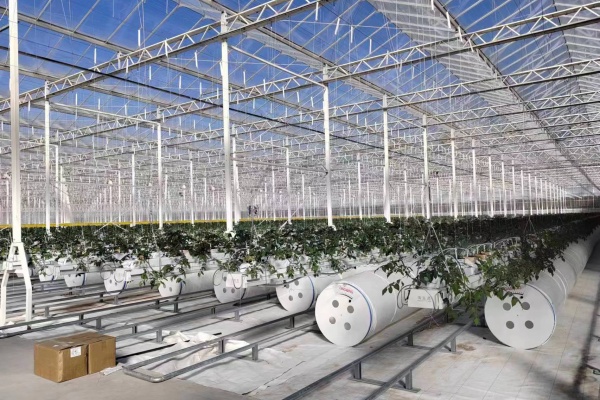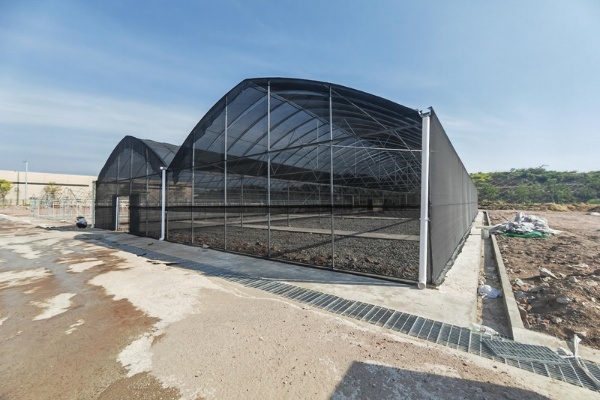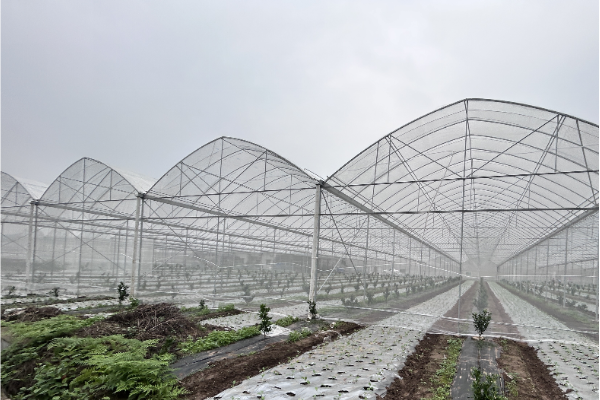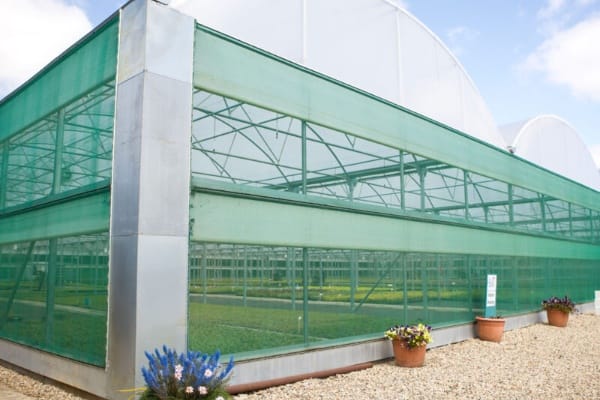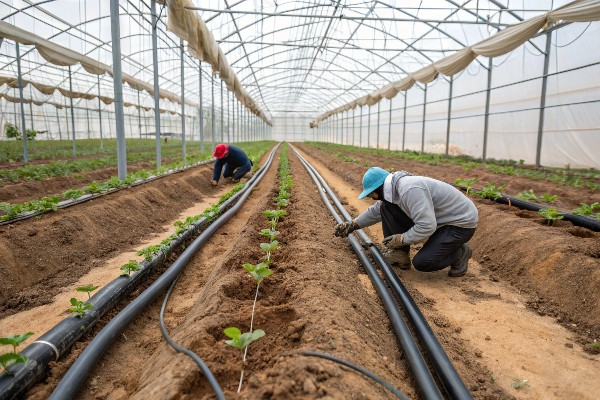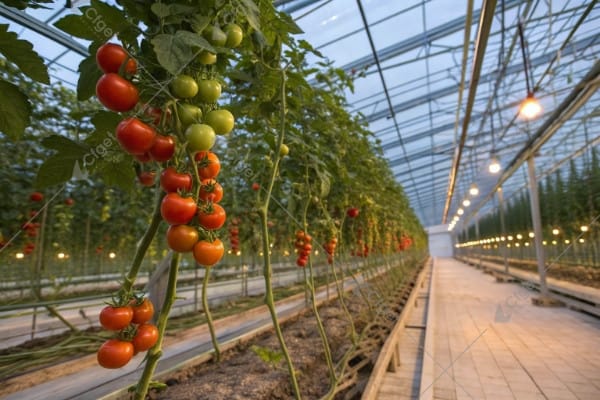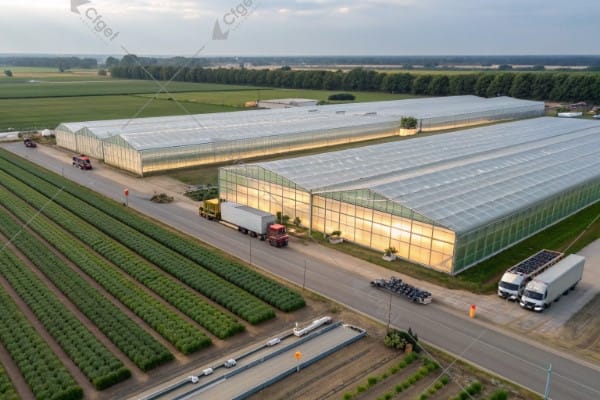Desert heat destroys crops and skyrockets cooling costs. Your investment becomes a liability instead of an asset. We engineer greenhouse solutions that thrive in extreme temperatures while keeping energy costs manageable.
You can build a profitable greenhouse in desert heat by using high shoulder heights, advanced shading systems, UV-resistant materials, and strategic orientation. These design elements work together to create a cooler microclimate while minimizing energy consumption for maximum profitability.
I will never forget my first project in the Arabian Peninsula. The client wanted to grow premium tomatoes in an area where summer temperatures regularly exceeded 50°C. Everyone told him it was impossible. The heat would kill the plants, and the cooling costs would bankrupt him. But we saw it as an engineering challenge. We designed a greenhouse with a 6-meter shoulder height, automated external shading, and a semi-closed cooling system. The result? He produced some of the highest quality tomatoes in the region, and his energy costs were 40% lower than a conventional design. This project taught me that extreme environments do not require you to fight against nature. Instead, you must work with the physics of heat, airflow, and solar radiation to create a profitable oasis. The key is understanding that every design decision in a hot climate greenhouse must serve the primary goal of heat management while maintaining economic viability.
How Do Smart Shading Systems Protect Your Crops from Intense Desert Sun?
Brutal desert sun can scorch your crops and overheat your greenhouse in minutes. Without proper protection, your plants suffer stress, and your cooling costs explode. Smart shading gives you precise control.
Smart shading systems use automated external screens and internal curtains to block excess solar radiation. These systems respond to real-time light and temperature data, providing optimal protection while maintaining enough light for photosynthesis, reducing cooling loads by up to 60%.
The challenge with desert sunlight is not just its intensity, but its relentless consistency. In temperate climates, clouds provide natural breaks in solar radiation. In desert environments, you face hour after hour of blazing, unfiltered sunlight. This creates a greenhouse effect that can push internal temperatures to lethal levels for plants. The solution is a multi-layered shading approach that acts like a sophisticated dimmer switch for the sun. I worked with a rose grower in North Africa who was losing entire crops to heat stress. The flowers were wilting before they could even bloom. We installed a dual-layer shading system with external aluminum screens and internal energy curtains. The external screens blocked the majority of the solar heat before it could enter the greenhouse, while the internal curtains provided fine-tuned control over the light levels reaching the plants.
The intelligence of modern shading systems lies in their ability to respond automatically to changing conditions. Sensors measure solar radiation, internal temperature, and even wind speed. When the sun is intense, the external screens deploy to their maximum position. As the sun moves across the sky or if clouds appear, the system adjusts incrementally. This precision ensures that plants receive exactly the right amount of light for optimal photosynthesis without the damaging excess heat. The energy savings are dramatic because you are preventing heat from entering the greenhouse rather than trying to remove it after it has already heated up the internal air mass.
The materials used in these shading systems are critical for desert environments. We use specialized aluminum strips or high-density polyethylene fabrics that are specifically designed to reflect rather than absorb solar radiation. These materials must also withstand the extreme UV radiation that is common in desert climates without degrading or losing their reflective properties over time.
| Shading System Type | Solar Heat Reduction | Light Transmission Control | Energy Savings |
|---|---|---|---|
| External Aluminum Screens | Up to 80% heat blocked | Maintains 40-60% light transmission | 50-70% reduction in cooling costs |
| Internal Energy Curtains | 30-50% heat reduction | Fine control from 10-90% light | 20-40% reduction in cooling costs |
| Retractable Shade Cloth | 60-75% heat blocked | Fixed percentage based on cloth density | 40-60% reduction in cooling costs |
| Smart Glass (Electrochromic) | Variable, up to 90% | Instant adjustment from clear to opaque | 30-50% reduction in cooling costs |
Which Glazing Material Survives Best in Extreme UV and Heat?
Desert UV radiation destroys standard greenhouse materials within years. Your covering becomes brittle, discolored, and ineffective. Choosing the wrong material means expensive replacements and crop losses.
UV-resistant polycarbonate sheets with special coatings outperform standard glass in desert environments. They provide superior impact resistance, better insulation, and longer lifespan when properly treated with UV stabilizers, lasting 15-20 years compared to 5-8 years for untreated materials.
The choice of glazing material in desert environments is literally a make-or-break decision. I have seen greenhouses where the covering material failed after just three years, turning yellow and brittle under the relentless UV bombardment. The replacement cost was enormous, and during the failure period, the crops suffered from reduced light transmission and poor climate control. This experience taught me that the initial material cost is insignificant compared to the long-term performance and replacement costs. For desert applications, we primarily recommend high-quality, UV-stabilized polycarbonate sheets, but the specific formulation and coating are crucial.
Standard polycarbonate, without proper UV protection, will degrade rapidly in desert conditions. The UV radiation breaks down the polymer chains, causing the material to become yellow, brittle, and eventually crack. However, polycarbonate sheets that are co-extruded with UV stabilizers and have a protective coating on both sides can withstand decades of desert exposure. These advanced materials maintain their clarity, structural integrity, and insulating properties throughout their lifespan.
Glass, while naturally UV-resistant, presents different challenges in desert environments. Standard float glass can handle the UV radiation without degradation, but it offers poor insulation, leading to higher cooling costs. Tempered glass is stronger and safer, but the thermal stress from extreme temperature swings between day and night can cause stress fractures over time. Coated glass options, such as low-E (low-emissivity) coatings, can significantly improve thermal performance by reflecting infrared radiation while allowing visible light to pass through.
The installation and sealing systems are equally important in desert environments. The extreme temperature fluctuations cause significant thermal expansion and contraction. The glazing system must be designed with appropriate expansion joints and high-quality sealants that remain flexible across a wide temperature range. We often use structural glazing systems with silicone sealants that are specifically formulated for high-temperature applications.
| Material Type | UV Resistance | Thermal Performance | Lifespan in Desert | Cost Factor |
|---|---|---|---|---|
| Standard Float Glass | Excellent | Poor (high heat gain) | 20+ years | Low initial cost |
| Low-E Coated Glass | Excellent | Good (reduced heat gain) | 20+ years | Medium cost |
| Standard Polycarbonate | Poor (yellows quickly) | Excellent insulation | 3-5 years | Low cost |
| UV-Stabilized Polycarbonate | Excellent | Excellent insulation | 15-20 years | Medium-high cost |
How Does Strategic Orientation Maximize Natural Cooling in Your Desert Greenhouse?
Poor greenhouse positioning fights against natural wind patterns and solar angles. This forces you to rely entirely on expensive mechanical cooling. Smart orientation works with nature to reduce your energy bills.
Strategic greenhouse orientation aligns the structure with prevailing winds for maximum natural ventilation while minimizing solar heat gain. East-west orientation with the long axis perpendicular to prevailing winds can reduce cooling energy needs by 30-40% compared to poorly oriented structures.
Understanding the local microclimate is the foundation of any successful desert greenhouse project. Before we design a single structure, we conduct a comprehensive site analysis that includes wind patterns, solar angles throughout the year, and topographical features that might affect airflow. I remember a project in Arizona where the client had already purchased land and wanted us to design a greenhouse. The site had a beautiful view, but it was positioned in a natural wind shadow created by nearby hills. We had to completely rethink the layout and even recommend additional land purchase to position the greenhouses where they could capture the prevailing winds. This decision saved them hundreds of thousands of dollars in cooling costs over the life of the project.
The primary goal of strategic orientation is to maximize the stack effect and cross-ventilation. Hot air naturally rises, and if you can create a clear path for this hot air to escape while drawing in cooler air from outside, you can achieve significant cooling without mechanical systems. We typically orient the greenhouse so that the prevailing wind hits the sidewall, creating positive pressure that forces air through the structure. The outlet vents are positioned on the opposite side and at the highest point of the structure to take advantage of the natural buoyancy of hot air.
Solar orientation is equally critical. In desert environments, the sun’s path is predictable and intense. By orienting the greenhouse to minimize the surface area exposed to the most intense afternoon sun, you can significantly reduce the solar heat load. This often means positioning the long axis of the greenhouse in an east-west direction, so the narrow end faces the harsh afternoon sun from the west.
The interaction between wind and solar orientation sometimes requires compromise. The optimal position for wind cooling might not be the optimal position for solar heat avoidance. In these cases, we use computational fluid dynamics (CFD) modeling to find the best balance. This computer simulation shows us exactly how air will flow through and around the proposed greenhouse under various wind and temperature conditions, allowing us to optimize the design before construction begins.
| Orientation Factor | Impact on Cooling | Design Consideration | Energy Savings Potential |
|---|---|---|---|
| Prevailing Wind Alignment | Maximizes natural ventilation | Position long side perpendicular to wind | 20-35% reduction in fan energy |
| Solar Heat Avoidance | Reduces afternoon heat gain | Long axis east-west orientation | 15-25% reduction in cooling load |
| Stack Effect Optimization | Enhances natural air movement | High outlet vents, low inlet vents | 10-20% improvement in air exchange |
| Topographical Considerations | Utilizes natural wind acceleration | Position on windward side of slopes | Variable, site-specific benefits |
How Do Shade Net Houses Provide Cost-Effective Growing in Extreme Heat?
Traditional greenhouses become too expensive to cool in extreme desert heat. You need production space, but the energy costs are prohibitive. Shade net houses offer a middle ground.
Shade net houses use specialized fabric structures to reduce solar radiation by 50-90% while maintaining natural ventilation. They cost 60-80% less than climate-controlled greenhouses and can extend growing seasons in hot climates without expensive cooling systems.
The concept of a shade net house represents a fundamental shift in thinking about protected agriculture in hot climates. Instead of trying to create a completely controlled environment, we work with the natural climate and modify only what is absolutely necessary. This approach dramatically reduces both the initial investment and the ongoing operational costs. I worked with a large-scale vegetable producer in the Middle East who needed to expand production but could not justify the energy costs of additional climate-controlled greenhouses. We designed a series of shade net houses that allowed them to triple their production area for the same budget they would have spent on a single traditional greenhouse.
The key to an effective shade net house is the selection and configuration of the shade fabric. Different crops require different levels of light reduction. Leafy greens like lettuce and herbs can thrive under 70-80% shade, while fruiting crops like tomatoes and peppers typically need only 40-50% shade. The fabric itself is a high-tech material, usually made from high-density polyethylene (HDPE) with UV stabilizers. The weave pattern and color of the fabric affect not only the amount of light that passes through but also the quality of that light.
Modern shade fabrics can be designed to selectively filter different parts of the light spectrum. Some fabrics are designed to block more of the infrared (heat) radiation while allowing more of the photosynthetically active radiation (PAR) to pass through. This selective filtering can create a cooler environment for the plants while still providing adequate light for photosynthesis.
The structure supporting the shade fabric is typically much simpler and less expensive than a traditional greenhouse frame. We use galvanized steel posts with cable or pipe supports to create a tensioned fabric roof. The sides can be left completely open for maximum ventilation, or they can be partially enclosed with additional shade fabric or insect netting depending on the specific requirements.
One of the biggest advantages of shade net houses is their flexibility. The shade fabric can be easily replaced or modified as crop requirements change. During cooler months, a lighter shade fabric can be installed to allow more light and warmth. During the hottest months, a denser fabric can provide maximum protection. This adaptability makes shade net houses an excellent solution for growers who need to respond quickly to changing market demands or seasonal variations.
| Shade Net Density | Light Reduction | Suitable Crops | Temperature Reduction |
|---|---|---|---|
| 35-50% Shade | Moderate protection | Tomatoes, peppers, cucumbers | $$3-5^\circ C$$ cooler |
| 50-70% Shade | High protection | Leafy greens, herbs, flowers | $$5-8^\circ C$$ cooler |
| 70-90% Shade | Maximum protection | Mushrooms, seedlings, nursery plants | $$8-12^\circ C$$ cooler |
| Specialized Fabrics | Selective spectrum filtering | High-value crops, research | Variable, optimized for specific needs |
What Are the Economics of Semi-Closed vs. Open Desert Greenhouses?
You need to decide between lower upfront costs and long-term operational efficiency. The wrong choice can make your operation unprofitable in desert conditions.
Semi-closed greenhouses cost 40-60% more initially but reduce energy consumption by 50-70% compared to open systems. For high-value crops in extreme desert conditions, the payback period is typically 3-5 years, making them more profitable long-term.
The economic decision between open and semi-closed greenhouse systems in desert environments is one of the most critical choices a grower will make. It affects not only the initial capital investment but also the operational costs, crop quality, and long-term profitability of the entire operation. I have worked with clients who made the wrong choice and struggled for years with either inadequate climate control or crushing energy bills. The key is understanding that the economics are not just about the greenhouse cost, but about the total system performance over its entire lifespan.
An open greenhouse system relies primarily on natural ventilation and evaporative cooling. The initial cost is lower because the structure is simpler and requires less sophisticated equipment. However, in extreme desert conditions, these systems often struggle to maintain optimal growing conditions during the hottest months. The result is reduced crop quality, lower yields, and sometimes complete crop loss during heat waves. When you factor in these production losses, the apparent cost savings of an open system can quickly disappear.
A semi-closed greenhouse system represents a hybrid approach that combines the best aspects of both open and closed systems. During moderate weather conditions, the greenhouse operates like an open system, using natural ventilation for cooling. However, during extreme conditions, the system can be sealed and rely on mechanical cooling to maintain optimal conditions. This flexibility allows the greenhouse to maintain consistent production throughout the year while minimizing energy consumption during favorable weather periods.
The key to the economic success of a semi-closed system is the sophisticated control system that manages the transition between open and closed modes. Sensors continuously monitor internal and external conditions, automatically deciding when to switch modes based on factors like temperature, humidity, wind speed, and energy costs. This automation ensures that the system always operates in the most energy-efficient mode possible while maintaining optimal growing conditions.
The crop value is a critical factor in this economic equation. For low-value crops like field vegetables, the additional investment in a semi-closed system may not be justified. However, for high-value crops like medicinal herbs, specialty vegetables, or cut flowers, the improved quality and consistency provided by a semi-closed system can command premium prices that easily justify the additional investment.
| System Type | Initial Investment | Annual Energy Cost | Crop Loss Risk | Payback Period |
|---|---|---|---|---|
| Open Greenhouse | $$\$150-250/m^2$$ | $$\$15-25/m^2$$ | High (20-40% in extreme heat) | N/A (baseline) |
| Semi-Closed Greenhouse | $$\$250-400/m^2$$ | $$\$8-15/m^2$$ | Low (5-10% in extreme conditions) | 3-5 years for high-value crops |
| Fully Closed Greenhouse | $$\$400-600/m^2$$ | $$\$5-10/m^2$$ | Very low (1-3%) | 5-8 years for premium crops |
How Do You Design Effective Natural Ventilation for Desert Conditions?
Poor ventilation design traps hot air inside your greenhouse, creating deadly conditions for plants. Mechanical cooling becomes your only option, driving up costs. Smart ventilation design works with physics to move air naturally.
Effective natural ventilation in desert conditions requires large vent openings (minimum 25% of floor area), proper positioning to capture prevailing winds, and tall structures (6+ meters) to maximize the stack effect. This design can maintain acceptable temperatures without mechanical cooling for much of the year.
Natural ventilation in desert environments is both an art and a science. The physics are straightforward: hot air rises, and if you provide a path for it to escape while drawing in cooler outside air, you can create significant air movement without any mechanical systems. However, the execution requires careful attention to vent sizing, positioning, and the overall greenhouse geometry. I learned this lesson early in my career when we designed a greenhouse in a hot, dry climate with what we thought were adequate vents. The internal temperatures were still reaching dangerous levels. We discovered that our vent area was too small and poorly positioned to capture the available wind. After retrofitting with larger vents and repositioning them to align with the prevailing wind patterns, the performance improved dramatically.
The fundamental principle is the stack effect, also known as the chimney effect. As air inside the greenhouse heats up, it becomes less dense and rises. If there are openings at the top of the structure, this hot air will naturally flow out, creating a low-pressure area that draws cooler outside air in through lower openings. The effectiveness of this system depends on the temperature difference between inside and outside air, the height of the structure, and the size and positioning of the openings.
In desert conditions, we typically design greenhouses with a minimum shoulder height of 6 meters, and often higher. This extra height serves multiple purposes. First, it increases the volume of air inside the greenhouse, providing more thermal mass that is slower to heat up. Second, it maximizes the stack effect by creating a taller column of rising air. Third, it creates more space between the crop and the roof, reducing the radiant heat that reaches the plants from the hot roof surface.
The sizing of ventilation openings is critical. As a general rule, we design for a total vent area that is at least 25% of the greenhouse floor area, and often more in extreme climates. This might seem excessive, but undersized vents are one of the most common causes of overheating in hot climate greenhouses. The vents must be positioned to work with, not against, the prevailing wind patterns. Inlet vents are typically positioned on the windward side of the structure, while outlet vents are positioned on the leeward side and at the highest possible point.
| Ventilation Design Element | Recommended Specification | Impact on Cooling | Critical Success Factor |
|---|---|---|---|
| Total Vent Area | Minimum 25% of floor area | Enables adequate air exchange rates | Must be distributed between inlet and outlet |
| Greenhouse Height | 6+ meters shoulder height | Maximizes stack effect and thermal mass | Higher is better, but increases structural costs |
| Vent Positioning | Inlet low/windward, outlet high/leeward | Optimizes natural air circulation | Must align with local wind patterns |
| Vent Type | Continuous ridge and side vents | Provides uniform air distribution | Automated operation essential for responsiveness |
Conclusion
Desert greenhouse success requires integrated design thinking. By combining smart orientation, advanced materials, strategic ventilation, and appropriate technology levels, you can create profitable growing operations even in the world’s harshest climates.

